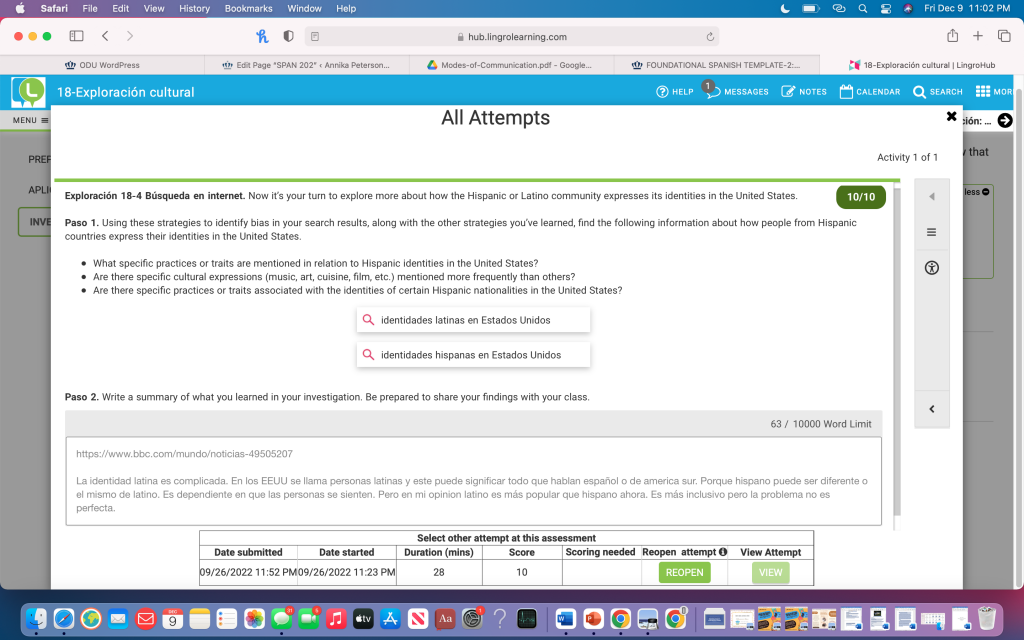Interpretive, Interpersonal, and Presentational Modes of Communication
Exploring Culture
I have been studying Spanish in school for almost 8 years in total, and I am just now getting comfortable with my abilities and going out of my comfort zone to engage with others in Spanish outside of school. I have been lucky to have great teachers and professors that prioritize not only learning the foundations of Spanish language-wise, but also talking, presenting, and learning about as much culture as possible to make us confident going into the real world. I have grown so much over the years, and I am really glad that I have gotten the opportunity to learn from and speak with so many different types of Spanish speakers. The world feels so big, but we have so much more in common with people across the globe than we realize, and I hope to continue this even after graduation.
Engaging in Communities
Learning another language is extremely important because it challenges your brain, pushes you to engage with other people and cultures, provides an opportunity to engage with others in your community, and makes you more well-rounded. Being able to know another language is such a great skill that can open many doors professionally and personally.
Interpersonal Communication
This class provided multiple opportunities to communicate with native Spanish speakers. We had a few 15-minute conversations using TalkAbroad to video chat with people from other countries.
As well as TalkAbroad, I also got to use Spanish a decent amount conversationally in my job as a sales associate at American Eagle. At least one customer every few days spoke Spanish, and I was so happy that I could communicate with them and help them with anything they needed. It made the customers very happy to have people who knew their native language. I also practiced with my coworkers who spoke Spanish. It made me so much more confident in my understanding and abilities with the language. I did not know everything, but everyone was patient and happy that I was putting forth effort to speak with them.
Presentational Speaking
All of the projects in this class required presentational speaking. This is a great practice for presenting in Spanish and in English.
I feel fairly comfortable presentational speaking in Spanish. It is one of. my strong-suits in English. I want to get better at trusting in my abilities to speak confidently.
Presentational Writing
In one of the modules, we discussed the traditions important to our family and culture. I did this in a discussion board with my classmates and in the online textbook.

I thought this was one of the most fun writing prompts because I loved sharing my own culture and learning about others’. I had to use wordreference.com to be able to translate some of the words that are not easily transitioned from Swedish to English tp Spanish, but it helped me learn new vocabulary that I can use in the future and is more specific toward my life and experiences.
Interpretive Listening
We watched a fair number of videos completely in Spanish. It requires active comprehension of the listener.
One thing we watched that I enjoyed was a video of an art museum in Buenos Aires that we watched in our online textbook. It was challenging because it was fast and made for native speakers, but it was interesting to hear from the different artists who had different accents and dialects. The above video was one of the most challenging, yet interesting, interpretive listening assignments.
Interpretive Reading
In this class, I read stories, online articles, and video subtitles fully in Spanish and had to comprehend and use them to explore aspects of different Spanish-speaking countries’ cultures and integrate new vocabulary. At the start of every module/chapter in the online textbook we were required to read a story, examine a piece of poetry, watch a video, etc. that incorporated aspects of the chapter to come. At the end of each module it required a cultural exploration using internet resources.

The most challenging part of this type of assignment was the use of unfamiliar vocabulary or grammar concepts in the reading material. However, this was also exciting because it was using real-life articles and works that were not catered towards those learning a new language. This made me feel more confident in my abilities that I could understand a fair amount of the readings.